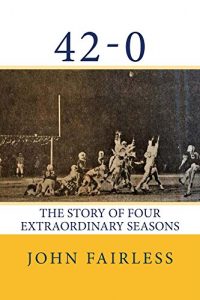There are times in life when a game is more than a game; 42-0 tells the story of a time when that became true, not only for a group of young men who gathered to play football, but for two entire towns and the better part of a state.
In 1967, a year after racial integration had begun in rural Tennessee, Coach Jim Graves assembled his group of players (white and black) and began an extraordinary journey that lasted for four seasons. Winning games "one at a time" (as almost all coaches will tell you is the only way you can), Coach Graves' Panther football team in Martin, Tennessee put up a perfect season (11-0) -- a rare-enough occurrence on its own.
The next season, despite Graves' departure, a new coach came in and did the same thing. 11 wins, no losses under Coach James Dunn.
A third season came along, and the results were the same; the fourth year of what finally became known as The Streak was thrilling, chilling, nerve-wracking and exciting -- for players and fans alike.
The fact that this football story takes place during some of the most tumultuous times in American history provides a constant subtext to the story told here. Racial tensions were running high, especially in the South, where some white people were not too happy about integration in the schools and in public places. (Not that all black folks were necessarily happy, either!)
The Vietnam War was a constant burden on the nation's resources, with thousands of American lives lost and thousands more young men who were never quite the same when they came back from war.
Assassination was a word that every citizen came to know, all too well -- Martin Luther King, Jr. was shot and killed in Memphis, Tennessee (about 100 miles from where our story takes place) in 1968, followed later that year by Senator Robert Kennedy, a candidate for President.
As author John Fairless asks in the book's introduction, "The world was coming closer every day, and it felt like a dangerous place to be. With all of that going on, just how important could a field goal and a football game be?"
It was important, indeed, for the better than 10,000 citizens gathered at the local stadium on a cold November night when the "The Streak" was on the line and two highly-ranked teams were battling it out.
Fairless writes: "I invite you to a time that is now suspended in memory, separated from the reality of modern life and our daily grind -- yet which remains as touchable and tangible as the thins we experienced only yesterday.
"Maybe -- for some of us -- they are more real than that.
Maybe -- just maybe -- a kick means more than winning or losing a game."
In 1967, a year after racial integration had begun in rural Tennessee, Coach Jim Graves assembled his group of players (white and black) and began an extraordinary journey that lasted for four seasons. Winning games "one at a time" (as almost all coaches will tell you is the only way you can), Coach Graves' Panther football team in Martin, Tennessee put up a perfect season (11-0) -- a rare-enough occurrence on its own.
The next season, despite Graves' departure, a new coach came in and did the same thing. 11 wins, no losses under Coach James Dunn.
A third season came along, and the results were the same; the fourth year of what finally became known as The Streak was thrilling, chilling, nerve-wracking and exciting -- for players and fans alike.
The fact that this football story takes place during some of the most tumultuous times in American history provides a constant subtext to the story told here. Racial tensions were running high, especially in the South, where some white people were not too happy about integration in the schools and in public places. (Not that all black folks were necessarily happy, either!)
The Vietnam War was a constant burden on the nation's resources, with thousands of American lives lost and thousands more young men who were never quite the same when they came back from war.
Assassination was a word that every citizen came to know, all too well -- Martin Luther King, Jr. was shot and killed in Memphis, Tennessee (about 100 miles from where our story takes place) in 1968, followed later that year by Senator Robert Kennedy, a candidate for President.
As author John Fairless asks in the book's introduction, "The world was coming closer every day, and it felt like a dangerous place to be. With all of that going on, just how important could a field goal and a football game be?"
It was important, indeed, for the better than 10,000 citizens gathered at the local stadium on a cold November night when the "The Streak" was on the line and two highly-ranked teams were battling it out.
Fairless writes: "I invite you to a time that is now suspended in memory, separated from the reality of modern life and our daily grind -- yet which remains as touchable and tangible as the thins we experienced only yesterday.
"Maybe -- for some of us -- they are more real than that.
Maybe -- just maybe -- a kick means more than winning or losing a game."












